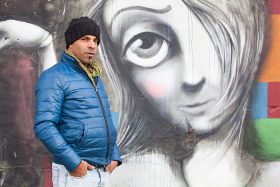Three Question for Anthropologists Dr. Dani Kranz and Katja Harbi
Our Academy programs regularly introduce new scholarship examining contemporary issues of migration and diversity. On May 4, University of Wuppertal anthropologists Dr. Dani Kranz and Katja Harbi will be presenting the results of the study they conducted, entitled Israeli Migration to Germany since 1990, with a lecture and show of photographs at the Jewish Museum Berlin. The research was largely about these immigrants’ identities and the significance of the Shoah for their lives in Germany, as well as the political and ideological debates occurring around them in Israel and Germany. We put three questions to the two anthropologists in advance of their presentation:
Dear Dani Kranz,
Research on Israelis in Germany is usually based exclusively in Berlin, the city with the most Israeli immigrants. For your study you conducted numerous interviews with Israeli Jews who live in a variety of German cities. Do the Israelis in Cologne and Munich, for instance, differ notably from those in Berlin?
Israelis reflect the general population of the cities in which they live. Berlin is a very young city, so the Israelis here are mostly younger. Many are single and looking to find themselves. Israelis in the other large cities often come to Germany with a clear goal, whether a specific course of study or to pursue a concrete job. On the other hand the Israelis who live in “the provinces” immigrate here for professional or lifestyle reasons, though sometimes also for love.
In the media there’s a lot of information circulating about how many Israelis are currently living in Germany. Some reckon their number to be around 17,000, others say it’s closer to 30,000. Is the wide range in estimates due to a lack of statistical data or is there another cause?
You have to understand the various, and usually much too high, statistical estimates of Israelis in Germany in the context of the trio of German/Jewish/Israeli history in Germany as well as of Israel’s Zionist ethos. From a German perspective, Israelis are particularly interesting migrants since they’re also Jews and their immigration can be interpreted as a completion of the reconciliation process with the Jewish people. From an Israeli perspective though, every Jew who emigrates from Israel is a loss. Thus migration takes on — oppositional — ideological significance in both countries.
Dear Katja Harbi,
As part of the study on Israeli Jews in contemporary Germany, a series of photographs were taken of German-Jewish couples as well as other subjects. How did you come up with the idea of approaching this field with methods from visual anthropology?
Visual anthropology, photography for the most part here, affords new entry points into a complex field of research, which is unfortunately often filled with truisms. As a continuously accessible medium, photography allows us to find our bearings and then later, with a trained eye, to recognize social contexts and developments that weren’t always apparent in the initial phase. An advantage that even “thick description” — the full, contextual interpretation of situations and spaces — often cannot match. Photographs can be a productive medium in interviews too, where the question is about identity formation: it’s often exactly through pictures that someone’s line of thinking, values, and emotions come to light, aspects that might have gone unmentioned in a purely verbal interview.
The questions were posed by Dr. Alina Gromova (Academy Programs), who also enjoys working on contemporary Jewish life in Germany.
Further information on the event at: www.jmberlin.de/en/talk-israelis-in-germany
